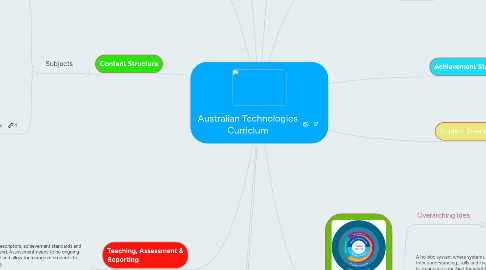
1. General Capabilities
1.1. The knowledge, skills, behaviours and dispositions required for students to thrive in the 21st century
1.1.1. Literacy
1.1.2. Numeracy
1.1.3. Information & Communications Technology
1.1.4. Critical & Creative Thinking
1.1.5. Personal & Social Capability
1.1.6. Ethical Understanding
1.1.7. Intercultural Understanding
2. Content Structure
2.1. Subjects
2.1.1. Design & Technologies
2.1.1.1. Strand: Knowledge & Understanding
2.1.1.1.1. The use, development and impact of technologies in peoples' lives.
2.1.1.1.2. Design concepts across a range of technology contexts.
2.1.1.2. Strand: Processes & Production skills
2.1.1.2.1. Critiquing, exploring, investigating needs or opportunities.
2.1.1.2.2. Generating, developing & evaluation design ideas for designed solutions.
2.1.1.2.3. Planning, making and evaluating designed solutions
2.1.2. Digital Technologies
2.1.2.1. Strand: Knowledge & Understanding
2.1.2.1.1. How data are represented and structured symbolically
2.1.2.1.2. The components of digital systems: software, hardware and networks
2.1.2.1.3. The use, development and impact of information systems on people's lives
2.1.2.2. Strand: Processes & Production
2.1.2.2.1. Collecting, managing and interpreting data
2.1.2.2.2. Using a range of digital systems and their components and peripherals
2.1.2.2.3. Defining problems and implementing their solutions
2.1.2.2.4. Creating and communicating information, especially online, and interacting safely using appropriate technical and social protocols.
3. Content Elaborations
3.1. Provided support material that outlines what is to be taught as an assistive tool for teachers. They further explain the content descriptors but do not necessarily cover all the required teaching.
4. Aims
4.1. The Technologies Curriculums overall aim is to develop students' knowledge, understanding, and skills in order to ensure that they can individually and collaboratively achieve the following things.
4.1.1. Students are creative, innovative and enterprising when using technologies and understand how they have changed over time.
4.1.2. Effectively and responsibly select and use appropriate technologies, resources, materials, data systems when designing and creating.
4.1.3. Critique and evaluate a range of technologies in order to find solutions to a variation of problems or opportunities.
4.1.4. Investigate, design, plan, manage, create, produce and evaluate technologies solutions
4.1.5. Engage confidently with technologies in order to make informed, ethical and sustainable solutions.
5. Cross Curriculum Priorities
6. Teaching, Assessment & Reporting
6.1. Based on the content descriptors, achievement standards and elaborations for each band. Assessment needs to be ongoing, relevant and meaningful and allow for a range of students to demonstrate their ability.
6.1.1. Both Formative and Summative assessment must be used. Formative: for the purpose of monitoring progress and providing feedback to teachers to improve their teaching, and to students to improve their learning. Summative: for the purpose of twice yearly formal reporting to the parents and carers.
7. Band Levels
7.1. F - Year 2
7.2. Years 3 & 4
7.3. Years 5 & 6
7.4. Years 7 & 8
7.5. Years 9 & 10
8. Content Descriptors
8.1. Each band level has a content descriptor that outlines the knowledge, understanding and skills teachers are expected to teach and that students are expected to learn.
8.1.1. F-2: builds upon the skills and concepts taught withing the Early Years Learning Framework. Focus' on developing basic computational thinking and how to use digital technologies to better understand personal experiences.
8.1.2. Yr 3-4: Further development and understanding of computational skills and creating awareness of how to use digital technologies in the home, school and community.
8.1.3. Yr 5-6: Sees students further developing their computational skills in ways such as looking at similarities and differences in problems and describing smaller features of complex problems. Focus' on the current and future sustainability of information systems.
9. Achievement Standards
9.1. Outlines the expected quality of learning students should typically achieve by a certain point in there education.
10. Student Diversity
10.1. All students are entitled to appropriate and engaging learning programs and it is the Teacher's consider the range of students level of learning, strengths, goals and interests. Teachers are flexible to cater for the diverse range of student needs.
10.1.1. Students with disability
10.1.2. Students with English as an additional language/dialect
10.1.3. Gifted and talented students
11. Key Ideas
11.1. Overarching Idea
11.1.1. To create preferred futures
11.2. A holistic system where systems thinking is taught to develop their understanding, skills and knowledge. In doing so, the aim is to to provide a method for identifying and moving towards ethical, socially responsible and sustainable ways of living.
11.2.1. Consideration of future generations and the environment.
11.2.2. Creatively and actively provide solutions to current problems without compromising the future needs of future generations.
11.2.3. Analysis of the parts, relationships and interactions between parts and components of a system.
